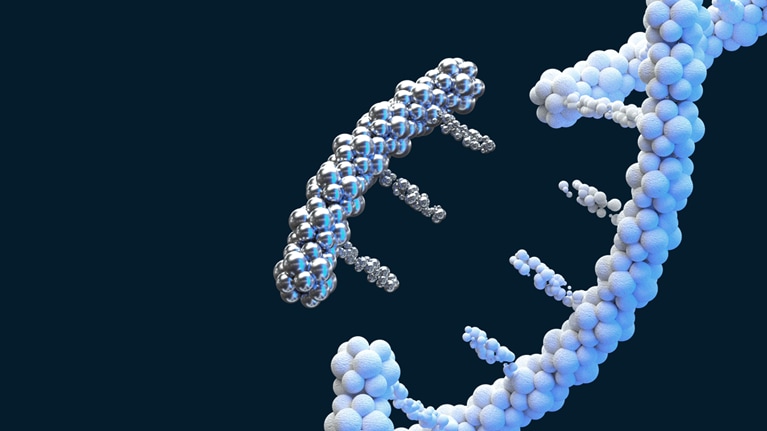
Biology, for many of us, may trigger memories of smelly classrooms and textbooks with pictures. But biology is way more than just high school science labs and frog dissection. It’s all around us, and it has major impact on the world—well beyond what you might think of as traditional science.
Biological engineering—or bioengineering—is the application of engineering principles to the design and transformation of technology for use toward solving biological problems. Breakthroughs in bioengineering stand to benefit organizations in a wide variety of sectors, including healthcare, food and agriculture, consumer products, sustainability, and energy and materials production. And the potential impact is large: aside from the transformational benefits to be gained in human health and well-being, as well as a more sustainably managed environment, McKinsey research suggests that some 400 use cases for bioengineering, almost all of which are scientifically feasible, could have an economic impact of $2 trillion to $4 trillion per year from 2030 to 2040.
What’s more, the wave of innovation is accelerating. The fields of computing, automation, AI, and data analysis advance faster with each passing year. According to SynBioBeta, a professional network for biological engineers, investment in synthetic-biology companies raised about $4.6 billion in the first quarter of 2021 alone, more than four times the investment in the same quarter a year earlier.
But it’s not as easy as just creating bioengineered products and raking in the rewards. Ethical, regulatory, and public-perception issues need to be settled first.
Learn more about McKinsey’s Life Sciences Practice and McKinsey Digital.
How did advancements in biological science help us cope with COVID-19?
Scientists were able to sequence and publicly share the whole COVID-19 genome just weeks after the first cases were reported in December 2019. This unprecedented speed was made possible by recent advances in biological technologies: when SARS broke out in 2002, it took more than five months for scientists to release full genome sequencing of the virus after the first reported case. Biological innovations also allowed for more effective diagnostics and new bioengineered treatments.
How does bioengineering relate to overall biological innovation?
Bioengineering is one area of biological innovation, propelled by a series of breakthroughs including the mapping of the human genome (completed in 2003) and the decreasing cost and speed of sequencing DNA. Advances in computing, data analytics, machine learning, and AI are also powering the change.
Biological innovations are grouped into four areas:
- Biomolecules: the mapping, measuring, and engineering of molecules.
- Biosystems: the engineering of cells, tissues, and organs. In both biomolecules and biosystems, recent advances are enhancing our understanding of biological processes, as well as enabling us to engineer biology. Engineering or modifying a living cell can cure or prevent disease; for example, the CRISPR tool allows scientists to edit genes more quickly and precisely than previous techniques.
- Biomachines: the interface between biology and machines.
- Biocomputing: the use of cells or molecules such as DNA for computation. Advances in both biomachines and biocomputing involve new and deep interactions between biology and machines. These new capabilities make it increasingly possible to measure neural signals and power precise neuroprosthetics for motor control of human or robotic limbs. What’s more, it’s now possible to store data using DNA. The storage density of DNA is about one million times that of hard disk storage. Technically, one kilogram of raw DNA could store all the data in the world.
Learn more about McKinsey’s Life Sciences Practice.
Which sectors are likely to be most affected by bioengineering?
As we’ve seen, human health and performance has the clearest pipeline from research to commercialization. The science is advanced, and the market is generally accepting of innovations. But more than half of the direct impact of bioengineering applications McKinsey has studied will likely be outside health over the next ten to 20 years. Let’s break down the sectors.

Looking for direct answers to other complex questions?
- Health and human performance
Bioengineering applications in the health sphere include cell, gene, and RNA therapies to treat or even prevent disease; a range of antiaging treatments to extend life spans; innovations in reproductive medicine; improvements to drug development and delivery; and new predictive modeling of human health and disease. The direct annual global potential impact is estimated at up to $1.3 trillion over the next ten to 20 years.
- Agriculture, aquaculture, and food
Bioengineering can support innovative new ways of breeding animals and plants using molecular or genetic markers. These methods are many times quicker than existing selective breeding techniques. Other applications include the development of alternative proteins such as lab-grown meat and efforts to quickly improve the microbiomes of plants, soil, animals, and water to nurture agricultural productivity.
- Consumer products and services
Opportunities are emerging to offer consumers personalized products and services based on their biological makeup. Applications may include direct-to-consumer genetic testing, beauty and personal care, and innovative approaches to wellness (and fitness) in humans and pets.
- Materials, chemicals, and energy
Applications here include innovations related to materials produced via fermentation, new materials with edited microbial DNA to enable things like self-repairing fabric, and innovative new forms of energy storage.
What kind of emerging biotechnologies are generating investor interest?
From 2019 to 2021, venture capital companies invested more than $52 billion in therapeutic-based biotech companies globally. Two-thirds of that went to start-ups with platform technologies, particularly those that can tailor treatments to individual patients and deliver the therapies to the target site with great accuracy.
Six platforms in particular are generating significant investor attention:
- Cell therapy 2.0 can more precisely address diseased tissues or cells or address a wider range of disease (such as solid tumors). The cell therapy 2.0 market is expected to reach $20 billion by 2026.
- Next-generation gene therapies can edit and modulate DNA and RNA and have the potential to cure genetic diseases. According to a McKinsey analysis of pharmaceutical industry data, around 400 gene therapies are currently in development; by 2025, they could comprise around 20 percent of new product launches.
- Precision medicine can diagnose conditions earlier than other diagnostic tools can and tailor therapies to patients’ specific genetic profiles.
- Drug discovery enabled by machine learning can cut through vast swaths of data to speed the discovery and development of new drugs. For example, a breakthrough in protein structure prediction by the open-source AI system AlphaFold regularly achieves accuracy competitive with manual experimentation.
- Strategies are being developed for “undruggable” targets including hard-to-hit proteins and hard-to-treat diseases. Research suggests that at least 85 percent of disease-associated proteins can be classified as undruggable, meaning there’s no binding site for conventional drugs or therapies.
- New delivery methods can send novel therapies to the entire affected tissue precisely and safely. Messenger-RNA-based vaccines like the ones developed for COVID-19 are among the most promising of these new delivery vehicles. This market is growing exponentially: more than 400 RNA-based therapies in the development pipeline will require targeted delivery mechanisms.
For more on these emerging tools, click here.
What are some risks involved with bioengineering?
If this all sounds a little too sci-fi for your comfort, you’re not alone. Many observers are concerned about the risks involved with bioengineering; even bioengineering proponents admit that risks could include potentially disastrous consequences at the population level. Needless to say, these risks could outweigh the benefits. Here are a few of the risks that will need to be carefully considered:
- Biology is self-replicating, self-sustaining, and does not respect jurisdictional boundaries. For instance, genetically engineered gene drives—intended to encourage the replication of one specific genetic trait—applied to vectors that spread disease, like mosquitoes, could have enormous benefits. But such gene drives are difficult to control and stand to permanently change ecosystems.
- The interconnected nature of biology can increase the potential for unintended consequences. Changes to one part of a system can have cascading effects and unintended consequences across entire ecosystems or species.
- While some biological technologies are relatively cheap, the resulting low barriers to entry could open the door to potential misuse—with potentially catastrophic consequences.
- Differing value systems make it hard to forge consensus, especially on life and death issues. Technical issues like embryo editing quickly become moral questions, and decisions are frequently a reflection of one’s value system.
- Privacy and consent issues are fundamental, given that the cornerstone of biological advances is data mined from our bodies and brains.
- Unequal access could perpetuate socioeconomic disparity, with potentially regressive effects. Biological advances and their commercial applications may not be accessible to all in equal measure, exacerbating socioeconomic disparity.
In addressing these risks, regulation will be important, as will oversight and monitoring of the science as it develops.
Learn more about McKinsey’s Life Sciences Practice and the McKinsey Global Institute.
How far are we from widespread adoption of bioengineering applications?
Beyond the serious risks that need to be reckoned with prior to and concurrently with further development of bioengineering applications, McKinsey sees three stages of the journey to adoption.
First, investment in scientific research—meaning funding, tools, talent, and access to data—is needed to enable bioengineering scientists to succeed. It generally takes years of research and significant investment to move a new application from the idea stage to feasibility.
Next will come commercialization and diffusion. Four factors will play a role here:
- A new biology-based product or service needs to compete with existing products and services not only on cost but also by offering higher-quality or new properties.
- Business models must be suited for what could be fast-changing landscapes.
- New biology-based products and services need good go-to-market strategies, including elements like pricing, sales, and marketing.
- Once new biology-based products and services have hit the market and attracted a customer base, they need to be scaled up quickly.
And finally, mechanisms governing use—including broad acceptance by society and regulators—are key at all stages. McKinsey has found that around 70 percent of potential impact of bioengineering advances could hinge on consumer, societal, and regulatory acceptance.
How can various stakeholders prepare for the new wave of biological science?
Change is coming. These fundamental shifts in biological science may confer significant benefits; to capture them, four groups of stakeholders need to work to understand the science and ensure that innovation is safe.
Innovators. Scientists govern their own research processes via peer review. But scientists also need to take into account the views of the communities in which they operate.
Businesses. Organizations can adapt strategies to take advantage of biological innovation, adopting a portfolio-based approach toward investment.
Civil society, governments, and policy makers. Some countries, including China, the United Kingdom, and the United States, have set the tone for informing themselves about biological advances and responding to them effectively. But innovation needs to be balanced by mechanisms to govern use and misuse.
Individuals. Potential consumers of bioengineering applications need to inform themselves about the benefits versus the risks of things like gene editing.
Learn more about McKinsey’s Life Sciences Practice. And check out life sciences-related job opportunities if you’re interested in working at McKinsey.
Pop quiz
Articles referenced:
- “Europe’s Bio Revolution: Biological innovations for complex problems,” January 10, 2023, Matthias Evers, Antonia Stein-Asmussen, Nicole Szlezak, and Alexandra Zemp
- “How AI can accelerate R&D for cell and gene therapies,” November 16, 2022, Mayank Bhandari, Amelia Chang, Thomas Devenyns, Alex Devereson, Alberto Loche, and Lieven Van der Veken
- “What are the biotech investment themes that will shape the industry?,” June 10, 2022, Olivier Leclerc, Michelle Suhendra, and Lydia The
- “The promise and peril of the Bio Revolution,” January 26, 2021, Matthias Evers and Michael Chui
- “The Bio Revolution: Innovations transforming economies, societies, and our lives,” May 13, 2020, Michael Chui, Matthias Evers, James Manyika, Travers Nisbet, and Alice Zheng
- “How the Bio Revolution could transform the competitive landscape,” McKinsey Quarterly, May 7, 2020, Michael Chui, Matthias Evers, and Alice Zheng



